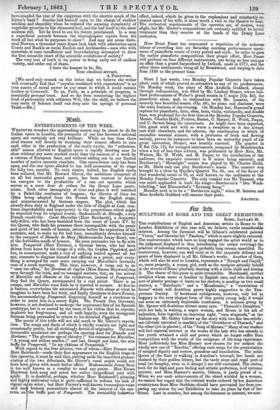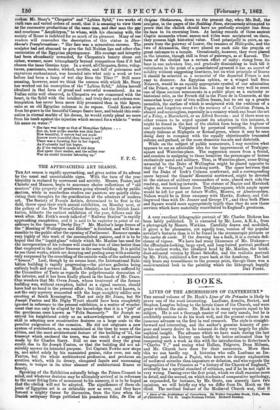filit arts•
SCULPTORS AT ROME AND THE GREAT EXHIBITION.
ROME, JANUARY 25. Tam contributions of English and American artists in Rome to the London Exhibition of this year will, we believe, excite considerable interest. Among the foremost will be Gibson's celebrated painted "Venus," and likewise his "Pandora," which is more slightly coloured. The controversies which have so long engaged the artist world as to the judgment displayed in thus introducing (or rather reviving) the practice of colouring statues, will probably long remain unsettled. No controversy, however, can well exist as to the exquisite delicacy and grace of form displayed in all Mr. Gibson's works. Another of them, which will also be sent to London, represents a "Nymph and Cupid," or, more properly, a young girl, such as the sculptor actually beheld in the streets of Rome playfully dancing with a little child and kissing it. The charm of this piece is quite irresistible. Macdonald, another sculptor whose name is familiar to English ears, and who displays a sort of plaster peerage of busts on his shelves, is sending us two small statues, a " Bacchante " and a " Mendic,ante," a "correlation of forces" which will doubtless prove highly suggestive to the Temperance Society. If bacchanal indulgences, however, only led to beggary in the very elegant form of this pretty young lady, it would not seem an extremely deplorable conclusion. A colossal group by Mr. Spence will doubtless attract many eyes. "Pharaoh's Daughter," with her lady in waiting, a negro woman, and Moses in his ark of bulrushes, form together an imposing sight, "cosa stnpenda," as the Italians say. Mr. Gatley follows up the story with two fine bas-reliefs: one (already executed in marble), of the " Overthrow of Pharaoh," and the other (yet in plaster), of the "Song of Miriam." Many of our readers will feel especial interest in the works of the lady who has already in her youth attained a skill and power which no longer suffer from competition with the works of the sculptors of life-long experience. Most judiciously has Miss Harmer now chosen for her subject the wholly new one of " Zenobia," offering such scope for the presentation of mingled dignity and sorrow, grandeur and humiliation. The noble Queen of the East is walking in A.ure.lian's triumph, her hands are chained by their golden fetters, but the tardy steps and regal port of head (so haughty, even as it droops!) are still sustained. The statue, both for its high and pure feeling and artistic perfection, is of extreme interest, and Miss Harmer's master, Gibson, is justly proud of it. When we see such achievements of the chisel wielded by a woman, we cannot but regret that the colossal works ordered by her American countrymen from Miss Stebbins should have prevented her from preparing any statue for our Exhibition to take its place by that of her friend. Last in number, but among the foremost in interest, we mus reckon Mr. Story's "Cleopatra" and "Lybian Sybil," two works of each rare and varied orders of merit, that it is amazing to view them as the successive productions of the same man, and that man the gay and courteous "Amphitryon," to whom, with his charming wife, the society of Rome is indebted for so much of its pleasure. Many of our readers will remember the description of this statue in Hawthonse's Transformations "Her face was a miraculous success. The sculptor had not shunned to give the full Nubian lips and other characteristics of the Egyptian physiognomy. His courage and integrity had been abundantly rewarded, for Cleopatra's beauty shone out richer, wanner, more triumphantly beyond comparison than if it had chosen the tame Grecian type. In a word, all Cleopatra, fierce, voluptuous, passionate, tender, wicked, terrible, and full of poisonous and rapturous enchantment, was kneaded into what only a week or two before had been a lamp of wet clay from the Tiber !" Still more amazing, however, must we think the success with which Mr. Story has worked out his conception of the "Lybian Sybil," Africa herself idealized in that form of grand and sorrowful womanhood. As an Italian critic well observe& in Cleopatra we are concerned with the heart, in the Sybil with the intellect; and truly deep and solemn contemplation has never been more fitly presented than in this figure, calm as an old Egyptian colossus in its repose. Could Keats arise from his grave in the beautiful Campo Santo here, and behold this realization in eternal marble of his dream, he would surely plead no more from his tomb against the injustice which seemed bra while to "write his name on water:"
"Her face was large as that of Memphian Sphynx . . But oh, how unlike marble was that face!
How beautiful, if sorrow had not made Sorrow more beautiful than beauty's self! There was a listening fear in her regard, As if calamity had but began
As if the vanward clouds of begun, days
Had spent their malice, and the sullen rear Was its stored thunder labouring up."
F. P. C.































 Previous page
Previous page